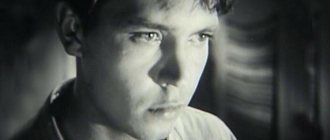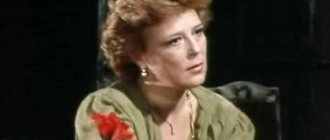Biography
Every Soviet child knew Natalya Klimova by sight - it was hard not to remember the beautiful and creepy Snow Queen. Once upon a time, the actress, who had brilliant talent and attractive appearance, was very popular. And then she seemed to disappear at the peak of her career, leaving many questions and not giving answers.
Natalya Klimova in her youth
Little is known about Natalya Ivanovna’s early biography. She was born on February 27, 1938, and after graduating from school she entered the construction institute. However, a year later the girl realized that her calling was theater, stage and the difficult craft of acting. Her studies were successful, and in 1963 Klimova graduated from the Moscow Art Theater School.
Movies
The aspiring actress’s memorable appearance was quickly noticed. Director Zacharias immediately after graduation invited Natasha to play the main role in the film “The End and the Beginning.” The film, shot strictly in a documentary style, marked the beginning of Klimova’s career as a film actress.
Natalya Klimova in the film "Engineer Garin's Hyperboloid"
Two years later, Natalya played her most striking role - the beautiful Zoe Monrose in the film adaptation of Tolstoy's story "The Hyperboloid of Engineer Garin." The film, shot in a noir style unfamiliar to the USSR, received controversial reviews from critics, but was loved by viewers.
Natalya Klimova in the film “The Snow Queen”
The next famous work was “The Snow Queen” - a picture that both children and adults still enjoy watching. After that, Klimova starred in two more children's films: in “The Snow Maiden” she appeared as Spring, and in “Tales of the Ural Mountains” she played the Mistress of the Copper Mountain.
Natalya Klimova as the Mistress of the Copper Mountain in the film “Tales of the Ural Mountains”
In parallel with her work in cinema, Natalya Ivanovna served in Sovremennik, whose morals and atmosphere horrified her. Subsequently, in rare interviews, the artist called the theater nothing more than “wolf cub.”
After 1970, Klimova suddenly disappeared from both movie screens and the theater stage, finally ending her acting career. The cause was a serious illness: Natalya Ivanovna was diagnosed with blood tuberculosis, one of the rarest forms of the disease.
Personal life
Klimova got married in 1962, becoming the wife of Zamansky, a popular Soviet actor. The love between the artists turned out to be mutual and strong - Vladimir and Natalya still live in marriage and do not part with each other. Although, according to the woman, the relationship developed quite normally, and was not wild love at first sight.
Natalya Klimova and her husband Vladimir Zamansky
In the 1970s, Klimova unexpectedly became interested in religion. The decisive role was played by an abortion performed in her youth, after which the actress could no longer have children. When Natalya became pregnant, she and Zamansky were not yet married, and the girl herself was just entering her 4th year. The loving couple had no time for the child, and they resolved the issue radically.
Three factors then prevented her from having a child: the consequences of an abortion, illness, and Natalia’s negative Rh factor. If a woman’s Rh factor is negative and the fetus’s is positive, the mother’s body perceives the child as a foreign object and produces antibodies to it. With each subsequent pregnancy, the number of antibodies increases, and the chance of bearing a child decreases.
Natalya Klimova in the film “First Russians”
Spiritual life became the reason why the actress finally abandoned the theatrical stage - for her they forever became the personification of sin. Natalya herself admitted that the profession has always been a burden for her. Therefore, the woman is even to some extent grateful to the disease - leaving the stage, the actress gained spiritual freedom.
Following his wife, Zamansky was also baptized, although he, unlike Natalya, did not stop acting. In 1981, Natalya and Vladimir got married. In one of his rare interviews, Vladimir Petrovich noted that his wife played the main role in his spiritual life. Without his wife, he would have come to Orthodoxy later, or perhaps he would not have come at all.
Natalya Klimova and Vladimir Zamansky in Murom
In 1998, the couple, tired of the bustle, left for quiet Murom. There they bought part of an old house, or rather an extension that had previously served as a bathhouse. The spiritual father gave his blessing for the couple to move. An important point because of which Natalya and Vladimir chose a place to live was the nearby Temple of St. Nicholas of the Embankment.
When Zamansky and Klimova bought the house, it was almost completely rotten; the premises had to be reconstructed and major repairs done. The couple sold everything they had, including furniture, and what they couldn’t sell they simply gave away.
Biography[ | ]
Born in Ryazan into the family of a Ryazan landowner, a sworn attorney, chairman of the Ryazan department of the "Union of October 17", member of the State Council Sergei Semenovich Klimov (April 24, 1850 - March 10, 1907 [ source not specified 111 days
]). In 1903, she graduated from the Ryazan Women's Gymnasium and entered the Lokhvitskaya-Skalon courses in St. Petersburg[1].
In 1906 she lived with her father on the Riviera. In May of the same year, she joined the Socialist-Revolutionary Maximalist Party. She met the Socialist Revolutionary M.I. Sokolov and married him. On August 12, 1906, she participated in the assassination attempt on Pyotr Stolypin (explosion on Aptekarsky Island). November 30, 1906 identified and arrested. In the casemates of the St. Petersburg DPZ she wrote the famous “Letter before execution,” which was published in the fall of 1908 in the magazine “Education.” Later, for children, Klimova wrote the story “Red Flower”[2].
In 1907, she was sentenced to death by a military court. Her father wrote an atypical petition for clemency, similar to a diary, and, having sent it away, died suddenly. According to Varlam Shalamov, it was his death that gave the petition the necessary force - the assistant commander-in-chief of the troops of the guard and the St. Petersburg Military District, Infantry General M. A. Gazenkampf, authorized to consider petitions for sentences of the St. Petersburg Military District Court and subordinate military courts, replaced the execution indefinite penal servitude. At the same time, quoting the text of the verdict, Shalamov cites the date when the death penalty was replaced by hard labor: January 29, 1907[2]. Natalya Klimova's father was still alive at that time.
On the night of June 30 to July 1, 1909, thirteen female convicts fled from the Moscow provincial women's prison (Novinskaya women's prison), along with the prison guard A.V. Tarasova. She hid in Moscow for a month. Then the Moscow Socialist Revolutionary engineer Vasily Kalashnikov took Natalya Sergeevna, as his wife, along the Great Siberian Road. On camels through the Gobi Desert, Klimova reached a Chinese port, and then by sea to Tokyo. From Japan by ship to Italy. From there to Paris[2].
In exile, he is a member of the AKP Combat Organization. Friend of Boris Savinkov. In 1911, she met Ivan Stolyarov, a social revolutionary and militant who escaped from the Chita penal servitude, and married him. In 1912, she retired from revolutionary activities, giving birth to her daughter Natalya. She did housework and gave birth to two more girls (the third appeared in September 1917).
After the February Revolution of 1917, the husband left for Russia and expected his wife and children to move later. Natalya tried to return to Russia, but was unsuccessful. In 1918, Natalya Sergeevna makes her last attempt to leave for Russia.
Her daughters fell ill with the Spanish flu while caring for them; Klimova herself became infected and died in Paris on October 26, 1918, following her youngest daughter[2]. She was buried in the Boulogne-Billancourt cemetery.
Her eldest daughter, translator, Natalia Ivanovna Stolyarova served an 8-year sentence in Karlag in 1937-1945[3].
Natalya Klimova now
There are practically no modern photos of Klimova on the Internet.
Natalya Ivanovna and her husband live quietly, trying not to attract attention and not advertise their personal life. They are devout and regularly visit the temple located near their home. The actors are no longer remembered, but even when rare journalists come to visit them, Klimova is reluctant to give interviews. She does not want to remind herself of how she played on stage - she believes that during this period she did nothing but sin.
Natalya Klimova now
In addition, the former actress does not have time to communicate with the press - Vladimir Petrovich is seriously ill, and he needs to be constantly looked after. Since the 1950s, the man has been tormented by terrible headaches - a reminder of his injury during the war.
Neighbors and the few remaining friends say that Natalya Ivanovna, out of religious zeal, does not even allow doctors to see her husband. In her opinion, the only thing that can help Vladimir is prayer.
The former actors live modestly, but they say that there is enough of everything. In Murom, Natalya and Vladimir are treated with great respect and, if help is needed, they help out. Klimova does not regret parting with the theater - she says that along with faith in life came peace and love, which were so lacking.
Interesting facts from life
Zamansky’s birthplace is the city of Kremenchug, which is located in the Poltava region, it was there that he was born in the winter of 26.
Photo: bolshoyvopros
The future artist experienced a difficult childhood - he did not have a father and therefore the family often lacked money. The boy wore out clothes borrowed from other children, and at home the most necessary food products were often absent.
When Vladimir was fifteen years old, Nazi Germany invaded the territory of the USSR. His mother died at the beginning of the war, and then the young man decided to go to the front. Since Zamansky had not yet reached adulthood, he needed to deceive the commission by adding 2 years to himself. The commission believed him, and the guy went to war as a volunteer.
Photo: 24smi
Zamansky was sent to a tank unit, with which he took part in the Battle of Orsha in 1944. The young soldier was seriously wounded, but continued to fight. He fought heroically until the end of hostilities, after which he remained to serve in the army.
Vladimir was awarded medals “For Courage” and the Order of the Patriotic War, second degree. Despite his services to the country, he was still sent to serve a nine-year sentence in the camps when, along with other soldiers, he injured a platoon commander.
Photo: rambler











